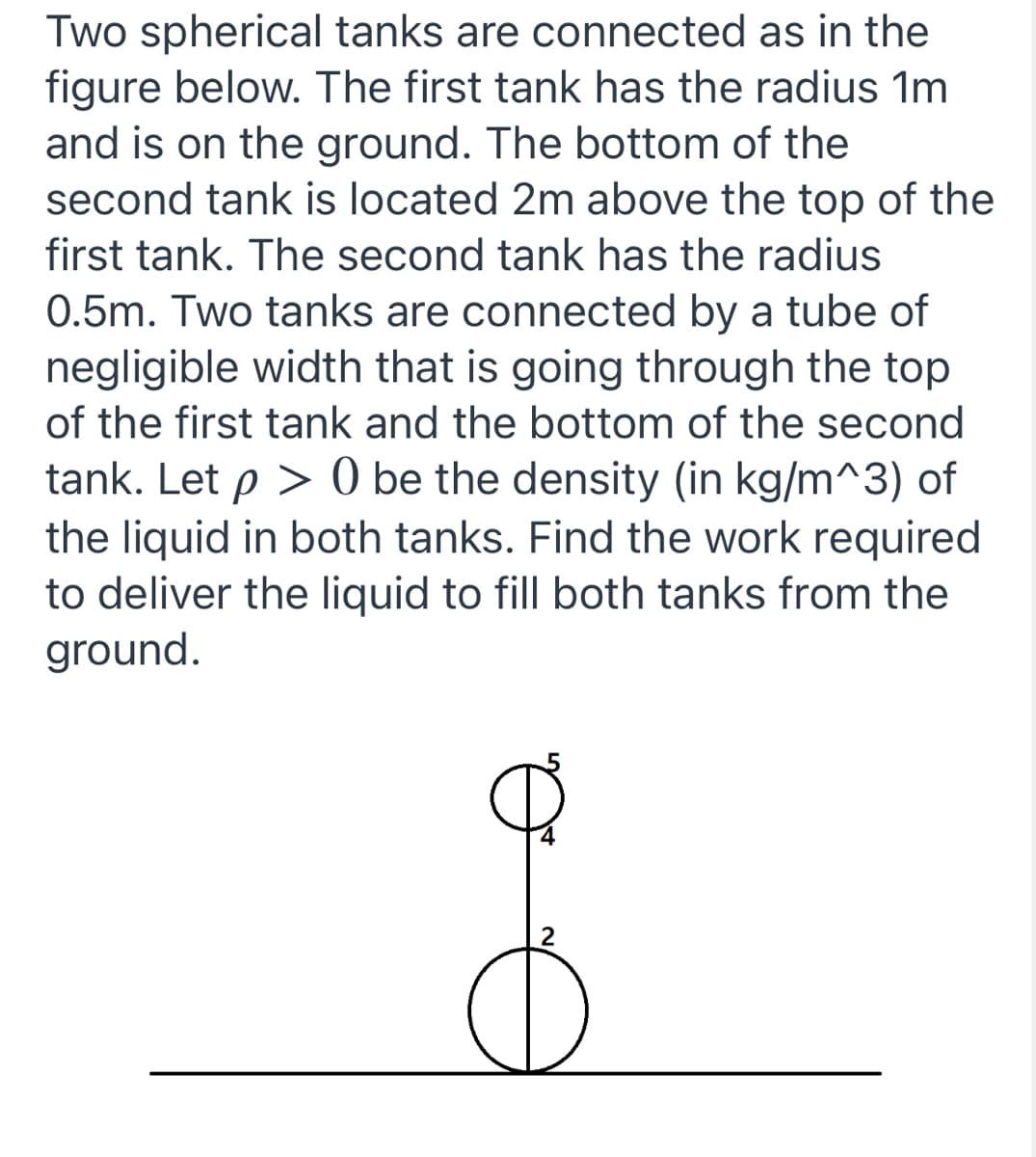Two spherical tanks are connected as in the figure below. The first tank has the radius 1m and is on the ground. The bottom of the second tank is located 2m above the top of the first tank. The second tank has the radius 0.5m. Two tanks are connected by a tube of negligible width that is going through the top of the first tank and the bottom of the second tank. Let p > 0 be the density (in kg/m^3) of the liquid in both tanks. Find the work required to deliver the liquid to fill both tanks from the ground.
Two spherical tanks are connected as in the figure below. The first tank has the radius 1m and is on the ground. The bottom of the second tank is located 2m above the top of the first tank. The second tank has the radius 0.5m. Two tanks are connected by a tube of negligible width that is going through the top of the first tank and the bottom of the second tank. Let p > 0 be the density (in kg/m^3) of the liquid in both tanks. Find the work required to deliver the liquid to fill both tanks from the ground.
Elementary Geometry For College Students, 7e
7th Edition
ISBN:9781337614085
Author:Alexander, Daniel C.; Koeberlein, Geralyn M.
Publisher:Alexander, Daniel C.; Koeberlein, Geralyn M.
Chapter9: Surfaces And Solids
Section9.3: Cylinders And Cones
Problem 34E
Related questions
Question

Transcribed Image Text:Two spherical tanks are connected as in the
figure below. The first tank has the radius 1m
and is on the ground. The bottom of the
second tank is located 2m above the top of the
first tank. The second tank has the radius
0.5m. Two tanks are connected by a tube of
negligible width that is going through the top
of the first tank and the bottom of the second
tank. Let p > 0 be the density (in kg/m^3) of
the liquid in both tanks. Find the work required
to deliver the liquid to fill both tanks from the
ground.
2
Expert Solution
This question has been solved!
Explore an expertly crafted, step-by-step solution for a thorough understanding of key concepts.
This is a popular solution!
Trending now
This is a popular solution!
Step by step
Solved in 3 steps

Follow-up Questions
Read through expert solutions to related follow-up questions below.
Follow-up Question
How come it is (.5)^2-(y-4.5)^2 and not (.5)^2-(h-1)^2?
Solution
Follow-up Question
How come it is 20y and not 20y^2/2 after
Solution
Recommended textbooks for you

Elementary Geometry For College Students, 7e
Geometry
ISBN:
9781337614085
Author:
Alexander, Daniel C.; Koeberlein, Geralyn M.
Publisher:
Cengage,

Linear Algebra: A Modern Introduction
Algebra
ISBN:
9781285463247
Author:
David Poole
Publisher:
Cengage Learning

Elementary Geometry For College Students, 7e
Geometry
ISBN:
9781337614085
Author:
Alexander, Daniel C.; Koeberlein, Geralyn M.
Publisher:
Cengage,

Linear Algebra: A Modern Introduction
Algebra
ISBN:
9781285463247
Author:
David Poole
Publisher:
Cengage Learning